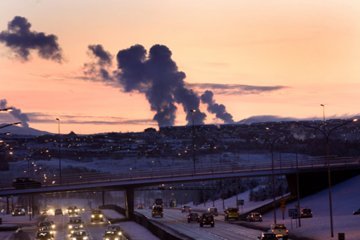In a recent report published in the Lancet it is claimed that switching to “clean energy” from fossil fuels will not only have beneficial effects on the environment, but also on people’s health since carbon intensive energy technologies simultaneously produce air pollution. According to the Salon, the report estimates that air pollution from the UK’s power sector is responsible for 3800 premature deaths per year. In order to combat this we are encouraged to transition to low-carbon energy technologies. That is all fine and well, but what low-carbon technologies are we talking about exactly?
Currently, the Icelandic National Power Company, Landsvirkjun (LV) is discussing the possibility of selling “clean” and “renewable” electricity to the UK via submarine cable and, as far as we are informed, some investors are interested in the plan. Almost 100% of Icelandic electricity is generally classified as renewable energy and therefore viewed as “low carbon” or “clean energy”.
There has been heated debate in Iceland surrounding further exploitation of its energy sources, which has led to the creation of an Energy Master Plan, which is supposedly to create consensus on the exploitation of hydropower and geothermal energy. Out of 25 of the highest ranking energy options, 21 are geothermal power plants. Constructions and plans for most of them is already underway.
The problem is that Geothermal Energy is not as “clean” as many would think, even though it is classified both as low carbon and renewable energy source. In fact, the production of electricity through the use of geothermal energy accounts to around 8 – 16% of Iceland’s CO2 release. However, Icelandic authorities do not consider those emissions anthropogenic and therefore do not count them as part of the country’s overall emissions.
A recent research by Ragnhildur Finnbjörnsdóttir, shows a correlation between increased numbers of death in Reykjavík and increased levels of hydrogen sulphide (H2S) from geothermal plants. The research was conducted between 2003 and 2009, and shows a 2-5% increase in deaths shortly after elevated levels of hydrogen sulphur. According to Finnbjörnsdóttir, hydrogen sulphur does not necessarily lead to any specific disease, but increases the seriousness of diseases people already suffer from.
Geothermal power plants emit hydrogen-sulphide (H2S), which is both corrosive and very toxic. H2S forms sulphur-dioxide (SO2) in the atmosphere, which can cause respiratory problems and asthma, as well as acid rain. From 1999 to 2012, the levels of SO2 in the Reykjavík area have risen by 71%. and in 2012, 80% of the SO2 released in Iceland came from Geothermal power plants.
In 2013 it was estimated that a year later the geothermal power plant in Hellisheiði, around 30 km from Reykjavík, would not be able to control H2S release under health regulation standards. Exact figures of H2S release from the power plant have not been released and due to a long standing volcanic eruption in Holuhraun in 2014, SO2 levels were elevated throughout the whole year, with the levels of SO2 at times reaching such levels that people tried their best to stay indoors.
More research on the health impact of SO2 from geothermal plants is needed, but a correlation between medicine costs and SO2 levels has already been established. In a 2010 study, Carlssen shows that in easterly winds in Reykjavík (blowing from the geothermal plant towards the city), medication costs rise by 2%.
In addition to the medical costs, the SO2 levels also lead to increased corrosion of metals, increasing the costs of replacement of circuit boards and other complicated electronics.
“Countries could quickly and economically reduce air pollution and its direct impacts on public health by transitioning to low-carbon energy technologies”
says the Lancet report. However, I do not recommend switching to geothermal energy if we are to avoid pollution-related deaths.
——————-
Helga Katrin Tryggvadóttir holds a MA degree in Development Studies from the University of Iceland and a BA in Anthropology from the same university.
An independent writer, freelance journalist and activist, Helga is currently researching the renewable energy sector in Iceland and its implications.

We have problems with geothermal in the Puna District of Hawai’i Island. What comes out of the ground is more than hydrogen sulfide. “The sampling and testing of the resource shall be preformed once upon experiencing the first steam release, and at least once during abated well cleanout and flow testing operations. Gasses to be tested:
ammonium (total), cadmium nitrates, arsenic carbonate, non-methane hydrocarbons, asbestos, fluorides (total), radionuclides, (a & b), benzene, hydrogen sulfide, radon, beryllium lead sulfates, bicarbonate, mercury (total), vinyl chloride, boron (total), methane”
After the release in August 2014, I ended up with chronic fatigue and it’s taken me 8 years to begin recovering. I’ve had hair tissue mineral analysis and hopefully soon I’ll get rid of my excessive aluminum and cadmium, along with the greater than a trace of arsenic, lead and mercury. One only needs a trace of thesetoxic metals.